If you’ve coached clients through weight loss or bodybuilding prep, you already know how tough long stretches of a low calorie diet can be. Energy dips, constant hunger, and frustrating weight loss plateaus often creep in. This is where a refeed day comes into play, especially in the context of understanding refeeding syndrome.
So, what is a refeed day? In simple terms, it’s a planned and controlled increase in calorie intake, mostly through carbohydrates, designed to reset the body and mind during a dieting phase, backed by scientific evidence. Unlike random overeating, refeed days are strategic. They help restore glycogen stores, balance hormones like leptin, and provide a much-needed break from continuous restriction.
For coaches, understanding the science behind refeeds is crucial. Properly scheduled refeeds can support fat loss while preserving fat free mass and skeletal muscle, helping to mitigate symptoms of prolonged caloric restriction. They can also boost metabolic rate, improve workout performance, and give clients the psychological lift they need to stay consistent.
In this blog, we’ll break down everything you need to know about refeeds—from refeed meaning and benefits to planning strategies and client-specific guidelines—so you can use them effectively in your coaching practice.
The Science Behind Refeeds: How the Body Responds
To understand why refeed days work, you need to look at what happens inside the body during a prolonged caloric deficit. When someone is on a low calorie diet for prolonged periods, their resting metabolic rate slows down, leptin levels drop, and glycogen stores in the muscles start to deplete. The body becomes efficient at conserving energy, which makes continued fat loss harder.
A refeed day introduces a controlled increase in calorie intake, mainly through carbohydrates. Carbs are crucial because they replenish glycogen stores in skeletal muscle, restore energy levels, and temporarily raise leptin, a hormone that regulates hunger and metabolism. This hormonal shift signals the body that it’s not in starvation mode, reducing the risk of muscle weakness and fatigue, which can sometimes be linked to low magnesium levels .
Key Physiological Effects of Refeed Days
In short, the science behind refeeds shows that they’re more than just extra food they’re a tool to keep fat loss sustainable while protecting fat free mass and maintaining client motivation.
Refeed Days vs Cheat Days: The Key Differences
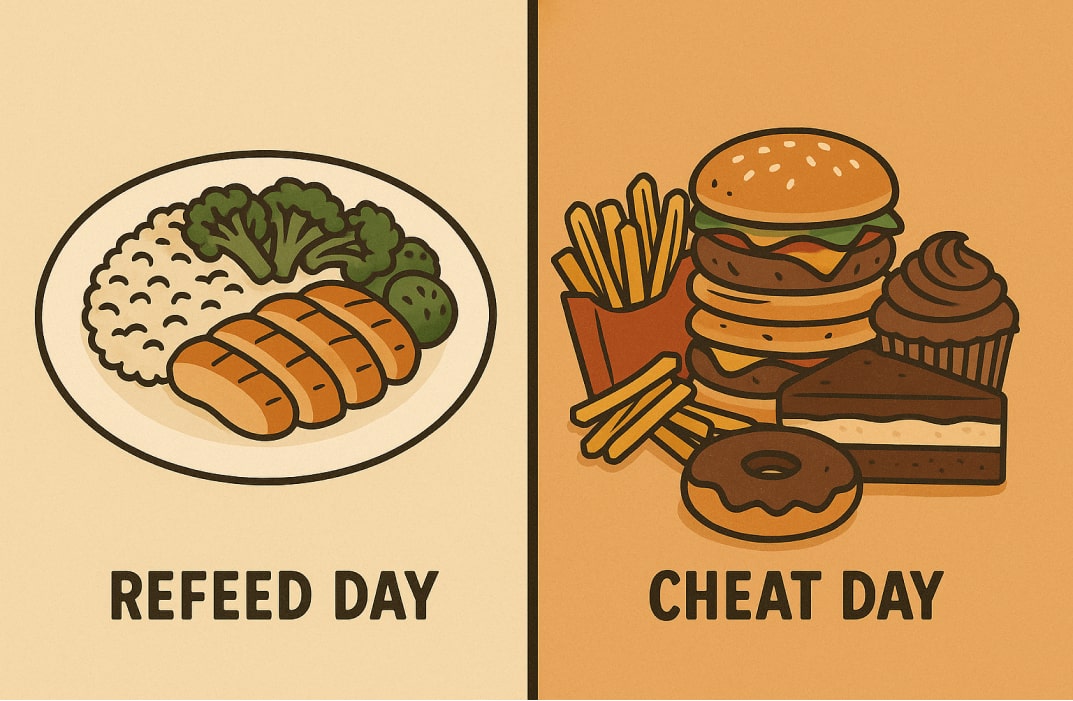
One of the biggest misconceptions in nutrition is confusing a refeed day with a cheat day. While they may sound similar, they serve very different purposes in a client’s diet.
A refeed day is structured and strategic, often considered a treatment for those struggling with weight loss plateaus . It focuses on a controlled increase in calorie intake—mainly from carbohydrates to restore glycogen stores, balance hormones like leptin, and prevent stalls in fat loss. Coaches often use refeeds in bodybuilding prep or during long-term low calorie diets.
A cheat day, on the other hand, is unplanned and often unrestricted. Clients may indulge in high-calorie foods loaded with fats and sugar. While it may provide short-term satisfaction, cheat days rarely optimize energy intake or support fat free mass maintenance. In fact, frequent cheat days can erase weeks of progress.
Comparison: Refeed Day vs Cheat Day
In simple terms, refeed days are about science; cheat days are about emotion. As a coach, guiding clients toward refeeds instead of uncontrolled cheat days can mean the difference between sustainable weight loss and repeated setbacks.
With FitBudd, you can easily plan refeed days inside a client’s nutrition calendar—keeping refeeds structured, data-driven, and aligned with their overall fat loss or performance goals.
How to Plan a Successful Refeed Day
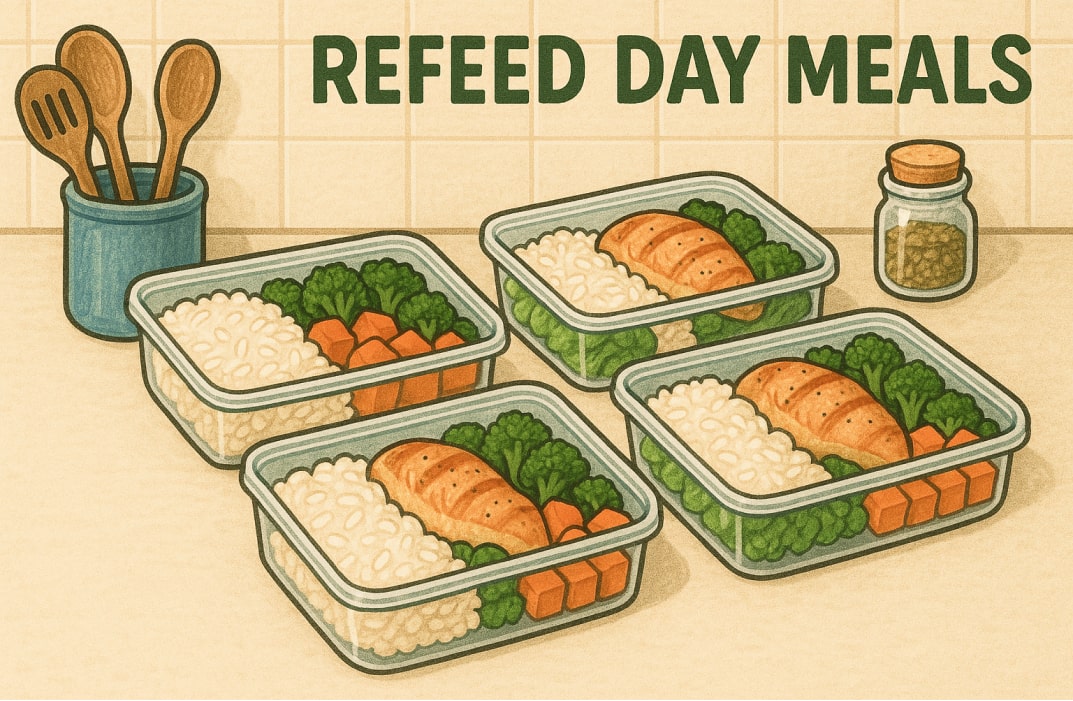
Knowing the refeed meaning is one thing, but applying it correctly is where real coaching skill comes in, as it's a complex process that requires careful planning. A poorly planned refeed can turn into a binge, while a well-structured refeed day can accelerate fat loss and preserve muscle mass.
Key Guidelines for Coaches
- Calorie Intake – Increase calories by 20–40% above the client’s dieting baseline, depending on body type and training load.
- Carbohydrates First – Most extra calories should come from carbohydrates, since they directly replenish glycogen stores and boost leptin levels.
- Protein Steady – Keep protein intake the same as on regular diet days to support skeletal muscle recovery.
- Fat Controlled – Avoid pushing fats too high, as they don’t provide the same hormonal benefits during a carb refeed.
- Timing Matters – Spread carbs across the day, focusing on pre- and post-workout meals for maximum performance benefits.
Sample Refeed Day Meal Plan
This approach ensures clients get the benefits of a refeed diet without sabotaging their long-term goals.
Benefits and Risks of Refeed Days for Clients
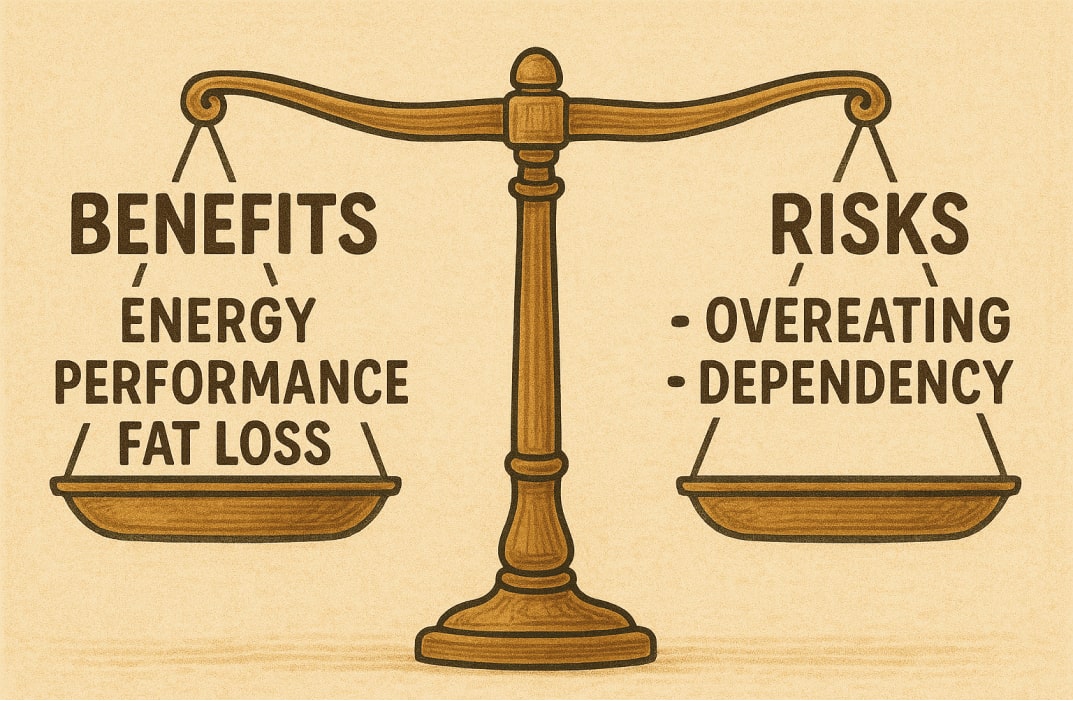
Like any nutrition strategy, refeed days come with both advantages and cautions. When coaches use them strategically, refeeds can be a game-changer for long-term fat loss and body composition. But when misapplied, they may do more harm than good.
Potential Benefits of Refeed Days
- Break Through Weight Loss Plateaus – A controlled bump in calorie intake and carbohydrates helps reset metabolism and keep fat loss moving.
- Protect Fat Free Mass – By refilling glycogen stores, refeeds reduce the risk of losing skeletal muscle during a prolonged caloric deficit.
- Boost Energy and Performance – Clients often feel more energy in workouts after a carbohydrate refeed, which improves training intensity.
- Improve Hormonal Balance – Temporary increases in leptin levels and other appetite-regulating hormones restore normal hunger cues.
- Psychological Relief – Planned refeed meals provide a sense of flexibility, reducing diet fatigue and stress.
Risks and Limitations Coaches Should Watch
- Overeating Beyond the Plan – Clients may mistake refeeds for “cheat days,” consuming excess calories and negating progress.
- Unsuitable for All Clients – Those struggling with obesity or disordered eating may find refeeds triggering.
- Dependency Risk – Some clients look forward to refeeds for indulgence rather than recovery, making adherence harder.
- Minimal Benefit Without Training – For sedentary clients, re feed strategies may not provide the same purported benefits as they do for athletes.
The bottom line is that refeeds are most beneficial when applied with precision. Coaches must individualize based on body weight, training intensity, fat mass, and client psychology.
With FitBudd, coaches can set boundaries around refeed days, track exact calorie intake, and keep refeeds structured—helping clients enjoy the benefits without falling into common traps.
When and How Often Should Refeeds Be Scheduled?
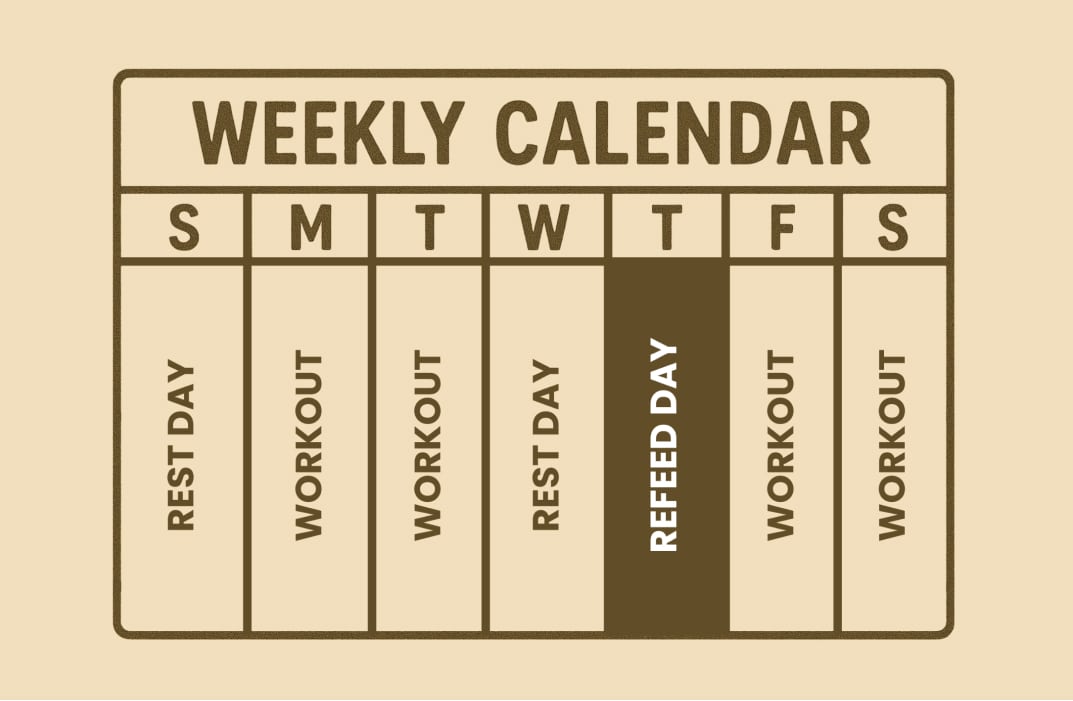
Knowing what a refeed day is is just the starting point. The real skill lies in deciding when to implement them and how often they should occur. A well-timed refeed can jumpstart metabolism, restore energy, and preserve fat free mass, while poorly scheduled refeeds can stall progress and cause unnecessary fat gain.
Signs a Client May Need a Refeed
As a coach, it’s important to recognize the warning signals that indicate a refeed is due:
- Weight Loss Plateaus – When a client’s body weight has remained unchanged for two or more weeks despite adhering to a caloric deficit, it may indicate that the body has adapted metabolically.
- Decreased Energy and Performance – Sluggish workouts, muscle weakness, and reduced training intensity are clear signs glycogen stores are low.
- Mood and Recovery Issues – Increased irritability, poor sleep, and delayed recovery can reflect hormonal shifts due to prolonged dieting.
- Persistent Hunger and Diet Fatigue – If a client constantly feels hungry, it may lead to poor adherence; a controlled refeed can provide a psychological reset.
Single-Day Refeeds vs Extended Refeed Weeks
The duration of refeeds varies depending on client goals and training demands:
- Single-Day Refeeds – Ideal for clients who are primarily looking to break a short-term plateau or boost energy for high-intensity workouts. Most commonly used in bodybuilding or strength training phases.
- Refeed Weeks – For more advanced strategies, like matador dieting, entire weeks may be dedicated to slightly higher calorie intake and carbohydrate consumption. This approach helps reset metabolism more thoroughly but requires careful monitoring to avoid fat gain.
Frequency Based on Client Goals
The frequency of refeed days should be individualized:
- Lean or Competitive Athletes – Often benefit from 1–2 refeeds per week to maintain glycogen stores and support performance while minimizing fat loss compromise.
- General Weight Loss Clients – May need a refeed every 2–3 weeks to prevent metabolic slowdown and combat diet fatigue.
- High-Intensity Training Clients – Those with frequent and intense sessions may require weekly refeeds to maintain energy levels and performance output.
- Clients with High Fat Mass – Refeeds should be sparing and carefully controlled, as the risk of overconsumption outweighs the benefits.
Adjusting Refeeds Dynamically
No two clients respond the same way. Monitoring is key:
- Track changes in body weight, fat mass, and energy levels.
- Adjust refeed frequency if clients continue to plateau or show signs of excessive fatigue.
- Use refeed days strategically around high-demand training sessions to maximize glycogen replenishment and recovery.
Tools like FitBudd make dynamic adjustment simple: coaches can schedule refeed days, track caloric intake, and fine-tune the plan based on real-time client feedback, ensuring refeeds deliver maximum fat loss and performance benefits without setbacks.
Refeeds in Popular Dieting Approaches

Structured refeed days aren’t just for bodybuilding they can be adapted to a variety of dieting strategies. Coaches often encounter clients on different diet plans and need to know how to integrate refeeds without compromising fat loss or muscle mass. Here’s how refeeds fit into some popular approaches.
Matador Dieting and Refeeds
Matador dieting is a cyclical dieting strategy where clients follow a strict low calorie diet for several days (commonly 5–6 days) followed by a single refeed day.
- Purpose: Reset metabolic rate, restore glycogen stores, and boost leptin levels.
- How to Apply: On the refeed day, calories—mostly from carbohydrates—are increased by 30–50% above baseline. Protein is maintained, and fats are kept moderate.
- Benefit for Coaches: This approach helps prevent long-term diet fatigue, improves adherence, and maintains skeletal muscle while continuing to support fat loss.
Intermittent Fasting with Refeeds
Clients following intermittent fasting often wonder how to include a refeed meal.
- Timing: Fit the refeed into the eating window, ideally around training sessions.
- Composition: Focus on carbohydrate refeed, adequate protein, and moderate fats.
- Why It Works: Even within a fasting protocol, a structured refeed ensures glycogen replenishment, reduces muscle weakness, and supports workout performance.
Bodybuilding Prep
Competitive bodybuilding often requires multiple refeeds per week during contest prep.
- Goal: Preserve fat free mass while continuing aggressive fat loss.
- Structure: One or two refeed days per week, with calories primarily from carbs, keeping protein consistent and fats controlled.
- Outcome: Clients experience improved training intensity, better recovery, and reduced psychological stress from prolonged dieting.
Practical Tips for Coaches
- Individualize Refeeds: Consider body weight, fat mass, training load, and client goals.
- Monitor Responses: Track energy levels, weight trends, and workout performance.
- Avoid Overeating: Ensure clients understand that a refeed is structured, not an excuse for unrestricted eating.
- Integrate Gradually: Start with one refeed per 1–2 weeks and adjust based on client response.
Coaching Tips for Managing Refeed Days Effectively
Implementing a refeed day is more than telling clients to eat extra carbs—it’s about strategic planning, monitoring, and individualization. Coaches play a vital role in ensuring refeeds maximize benefits while minimizing risks.
Understand Client Goals and Body Composition
Before scheduling a refeed, consider:
- Fat Mass vs Fat Free Mass – Clients with higher fat free mass may tolerate more frequent or larger refeeds.
- Training Phase – Athletes in intense strength training or bodybuilding prep need refeeds to support muscle recovery and performance.
- Dieting History – Long-term low calorie diets require more careful refeeds to prevent metabolic slowdown and diet fatigue.
Plan Refeeds Around Training
- Pre-Workout Carbs – Schedule part of the refeed before intense training sessions to maximize glycogen stores and improve performance.
- Post-Workout Recovery – Ensure adequate protein and carbohydrates post-training for muscle repair and hormonal balance.
- Avoid Inactivity – Using a refeed on a rest day without activity may reduce its metabolic benefits.
Monitor and Adjust
Coaches should track:
- Body Weight and Fat Mass – Check changes to ensure the refeed is effective but not excessive.
- Energy and Performance Levels – Low energy may indicate a need for more frequent or larger refeeds; excessive fat gain may mean scaling back.
- Client Feedback – Psychological response is as important as physiological: clients should feel energized, not guilty or out of control.
Educate Clients on the Difference Between Refeeds and Cheat Days
Help clients understand that a refeed day is structured, not an excuse to overindulge. Educate them about:
- Calorie and carbohydrate targets.
- Importance of nutrient timing.
- How refeeds support fat loss and muscle maintenance.
Use Technology to Streamline Management
Platforms like FitBudd allow coaches to design, schedule, and track structured refeed diets effortlessly. Coaches can monitor client progress in real time, adjust calorie intake dynamically, and provide accountability—all while keeping refeeds aligned with long-term goals.
Making Refeed Days Work for Your Clients
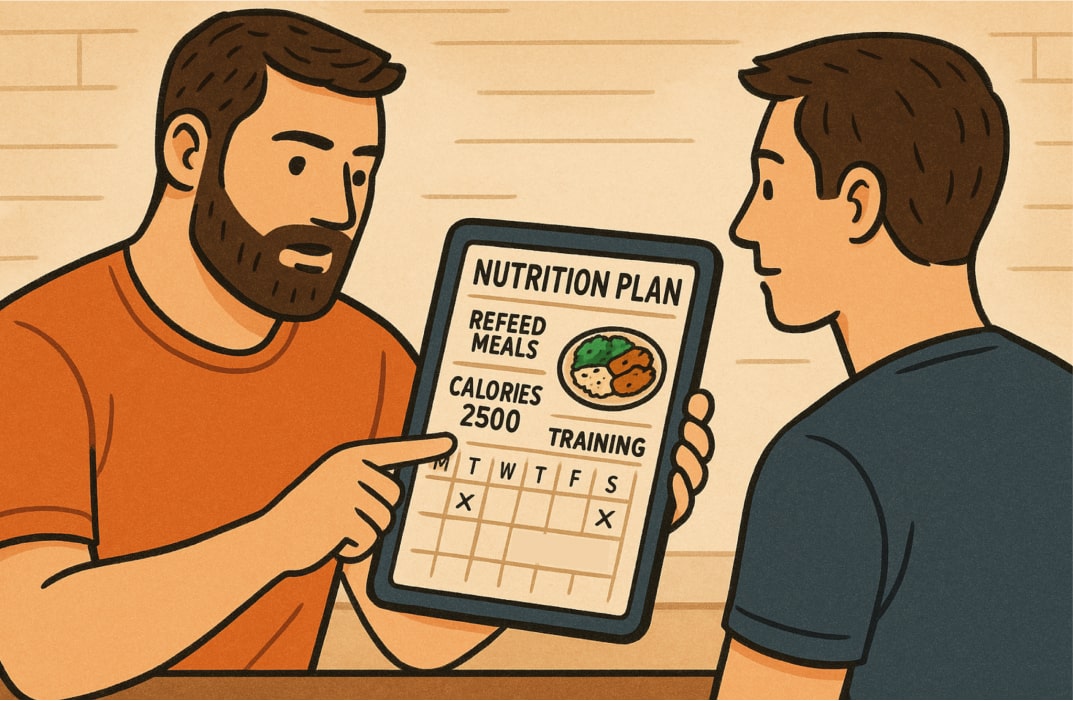
Structured refeed days are a powerful tool for coaches looking to optimize fat loss, protect fat free mass, and keep clients motivated. Unlike random cheat days, refeeds focus on strategic calorie intake, primarily from carbohydrates, to restore glycogen stores, boost leptin levels, and improve energy for training.
When implemented correctly, refeeds can break weight loss plateaus, enhance workout performance, and provide a psychological reset that helps clients stick to their long-term diet and training programs, ultimately improving overall fitness. Coaches play a crucial role in timing refeeds, adjusting calories, and individualizing strategies to match each client’s goals and body composition.
By integrating structured refeed days into your coaching plan, you can ensure clients not only reach their goals faster but also maintain muscle mass, metabolic health, and overall motivation. Refeeds aren’t just extra food—they’re a science-backed strategy to make dieting smarter and more effective.
Take Your Refeed Planning to the Next Level with FitBudd
FitBudd makes it easy for coaches to design and manage structured refeed diets. You can schedule refeed days, track client progress in real time, and adjust calorie intake, macros, and meal timing based on individual needs.
With FitBudd, your clients enjoy the full benefits of refeeds—more energy, better performance, and sustainable fat loss—without the stress of manual tracking.
92% trainers worldwide gave us 5 stars
Talk to your dedicated success manager and launch your branded fitness app during the demo in minutes.
Start your paid subscription for $79 FREE





%20to%20Become%20a%20Certified%20Personal%20Trainer-min.jpg)





